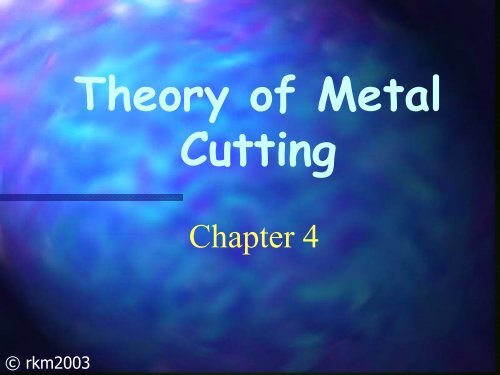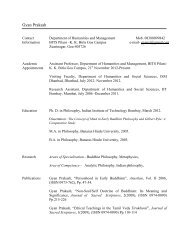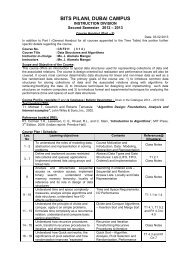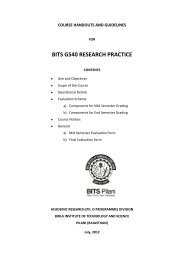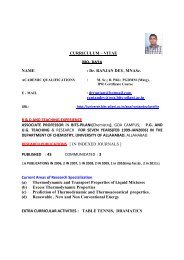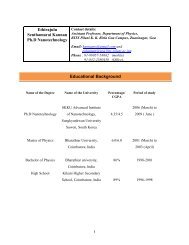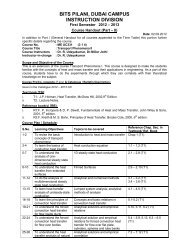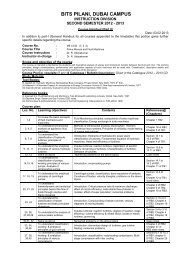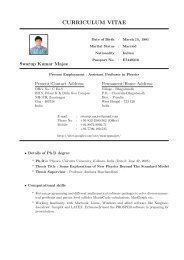Theory of Metal Cutting
Theory of Metal Cutting
Theory of Metal Cutting
- No tags were found...
Create successful ePaper yourself
Turn your PDF publications into a flip-book with our unique Google optimized e-Paper software.
<strong>Theory</strong> <strong>of</strong> <strong>Metal</strong><strong>Cutting</strong>Chapter 4© rkm2003
© rkm2003Typical <strong>Metal</strong><strong>Cutting</strong> Operation
Machining or <strong>Metal</strong><strong>Cutting</strong> Removing unwanted material <strong>Cutting</strong>/chipping/machining/metal cuttingTo get desiredShapeSize© rkm2003Surface finish
ypical Machining ExampleChanging shape/size/finish(a) Raw Material(b) Finished ProductUnwanted materialto be removed© rkm2003
© rkm2003<strong>Metal</strong> <strong>Cutting</strong>: featuresCloser dimensional accuracySurface texture/finishEconomicalComplex shapeSize
<strong>Metal</strong> <strong>Cutting</strong>: featuresMaterial loss (~50%)Scarcity <strong>of</strong> materialsSpecial equipmentSkilled operatorsTime requiredAll materials cannot be machined© rkm2003
Essentials <strong>of</strong> <strong>Metal</strong><strong>Cutting</strong> Operation• Machine Tool• <strong>Cutting</strong> Tool• Method• Operator© rkm2003A typical<strong>Cutting</strong> Tool
© rkm2003Machine ToolMachine used for metal cuttingprovision for holding workpieceprovision for holding toolrelative motion between themproviding power/energy
Typical Machine toolToolWorkpieceViseTablef or dTool headd or fRamvColumnBase© rkm2003
© rkm2003Different Machine ToolsType <strong>of</strong> surface –flat/circular/complex<strong>Metal</strong> <strong>Cutting</strong> Machine Tools<strong>Metal</strong> Forming Machine Tools
© rkm2003Classification <strong>of</strong>Machine Toolsdegree <strong>of</strong> specializationgeneral/specialmotionrecipocatory/rotaryautomationmanual/semi-auto/autosurfacecylidrical/flatduty cycleL/M/Henergyconventional/non-conventional
Mechanism <strong>of</strong> <strong>Metal</strong><strong>Cutting</strong>Tool & Workpiece interactionTool penetration(depth <strong>of</strong> cut)ForceToolChipWorkpieceRelative motionbetween tool andworkpiece (cutting speed)
© rkm2003<strong>Cutting</strong> Toolssharp edge/strong/hard/toughshape/size/method <strong>of</strong> holding Requirements Common materials Alloying Types Tool geometry
© rkm2003Types <strong>of</strong> ToolsSingle PointMultipoint
<strong>Metal</strong> <strong>Cutting</strong> ..© rkm2003BasicsFeaturesEssentialsMachine ToolsDifferentClassificationMechanism <strong>of</strong> <strong>Metal</strong> <strong>Cutting</strong><strong>Cutting</strong> ToolsRequirementsTool MaterialsTypes <strong>of</strong> tools
Geometry <strong>of</strong> Single Point Tool..Tool Signature8 – 14 – 6 – 8 – 8 – 19 – 1© rkm20038 – Back Rake Angle14 – Side Rake Angle6 – End-relief Angle8 – Side Relief Angle8 – End <strong>Cutting</strong> Edge Angle19 – Side <strong>Cutting</strong> Edge Angle1 – Nose Radius
© rkm2003Geometry <strong>of</strong> Single Point Tool..RH & LH ToolRight hand toolSide cuttingEdgeLeft hand toolSide cuttingEdge
Orthogonal and Oblique<strong>Cutting</strong>© rkm2003M achinedToolM otion <strong>of</strong>W orkpieceChip<strong>Cutting</strong> edgeat 90°Orthogonal cutting<strong>Cutting</strong> edgeinclinedToolChipM otion <strong>of</strong>W orkpieceOblique cutting
© rkm2003Types <strong>of</strong> ChipsBuilt-upChipedgeChipToolWorkpieceContinuouschipDiscontinuouschip
Types <strong>of</strong> Chips ..• Continuous Chip – chip breaker• Discontinuous Chip• Chip with Built-up Edge Workpiece material Tool geometry <strong>Cutting</strong> conditions© rkm2003
Thermal Aspects inMachiningHeat generated in cutting operationeffects:1.Tool2.Workpiece3.Machine tool• Surface• accuracy© rkm2003depends:Rate <strong>of</strong> <strong>Cutting</strong> cutting conditionsWorkpiece material
Thermal Aspects in Machining..© rkm2003Distribution <strong>of</strong> Heatheat generated in machiningoperation chips+tool+workpiece+environmentQ = Q1 + Q2 + Q3 + Q4Q1=heat taken away by the chipsQ2=heat conducted in to toolQ3=heat conducted in to workpieceQ4=heat dissipated in environment
Thermal Aspects in Machining..Distribution <strong>of</strong> Heat..Heat dissipation• depends on cutting speedTo keep cuttingzone temperaturelowCooling% HeatWork 10%Tool 10%Chips 80%<strong>Cutting</strong> Fluid© rkm2003<strong>Cutting</strong> Speed v
<strong>Cutting</strong> Fluidsabsorb and carry away the heatcool the workpiece and tool.reduce the frictionwash away the chips.carry away the built-up edgesformed.give very fine surface finishprevent corrosion© rkm2003
© rkm2003Operating ConditionsConditions (motions) required formetal cutting to take placeOperating or <strong>Cutting</strong> Conditions<strong>Cutting</strong> Speed v – m/sFeed f – mm/s or mm/rev ormm/minDepth <strong>of</strong> Cut d – mmMaterial Removal Rate MRR – m 3 /sMachining/<strong>Cutting</strong> Time
© rkm2003Tool LifeWear <strong>of</strong> sharp edge dull tooltime between two successiveresharpeningsTime for which tool cuts effectivelyInfluencing Factors1. Operating/cuttingconditions2. Workpiece material3. Tool material4. Geometry <strong>of</strong> tool5. Use <strong>of</strong> Coolant
Tool Life ..<strong>Cutting</strong> Speed (v)tool life (T)Taylor’sExpressionorTool LifeEquation© rkm2003log v0Intercept (log C)1Slope (n)θ 2log T
Tool Life..Taylor’s ExpressionvT n =Cv = <strong>Cutting</strong> Speed (m/min)T = Tool Life (min)n, C are constants. C = Interceptn = Slope <strong>of</strong> linen= tanθ=logv1−logv2© rkm2003logT1−logT2
Tool Life..Typical n & C VALUESWorkmaterialToolmaterialnCSteelCast Iron© rkm2003HSS 0.1-0.16 160-190Carbide 0.18-0.2 220-290HSS 0.08-0.1 100-180Carbide 0.2-0.28 250-325
Tool Life..Effect <strong>of</strong> depth <strong>of</strong> cut and feed on toollifelog vlog flog dθ3θ2vθ1dfθ1 > θ2 > θ3log T© rkm2003vTnfn1dn2=C
Machinability• Tool life• <strong>Cutting</strong> Speed• Force/power• Accuracy/finishEase <strong>of</strong> machining© rkm2003A relative measure•<strong>Cutting</strong> Forces/power•specific cutting speed – CS fortool life T
Machinability ..Machinability= (v t /v s ) x 100%v s – specific CS for standard materialv t – specific CS for test materialMachinability is affected by• Condition <strong>of</strong> machine/tool• <strong>Cutting</strong> conditions• Type <strong>of</strong> operation• work material© rkm2003
© rkm2003EXAMPLE 4.1While machining carbon steel by a tungstenbased steel tool, tool life <strong>of</strong> 50 minuteswas observed when machined with acutting speed <strong>of</strong> 100 m/min. Determine(a) General Taylor’s tool life equation and(b) tool life for a cutting speed <strong>of</strong>80 m/min. Assume n = 0.09.Work material: carbon steelTool material: tungsten based tool steel
EXAMPLE 4.1 ..SolutionGiven: v =100 m/min, T =50 min, n =0.09Taylor’s Eqn. vT n =Cor Log v + n log T = log Cor Log 100+ 0.09 log 50 = log Cor C = 142.20Hence: vT 0.09 =142.2© rkm2003
EXAMPLE 4.1 ..Solution(b)Given: vT 0.09 =142.2, v = 80 m/min,T = ?80 .T 0.09 =142.2orT= 596.57 min© rkm2003
EXAMPLES Example 4.3 A carbide-cutting toolwhen machined with mild steelworkpiece material at a cutting speed <strong>of</strong>50 m/min lasted for 100 minutes.Determine the life <strong>of</strong> the tool when thecutting speed is increased by 25%. Atwhat speed the tool is to be used to geta tool life <strong>of</strong> 180 minute. Assume n =0.26 in the Taylor’s expression.
EXAMPLES Solution: Given data: v1 = 50 m/min,T1 = 100 min, n = 0.26For 20% higher speedv2 = 1.25v1 = 62.5 m/minWe know that v1 T1^n = v2 T2^nSubstituting the values, we getT2 = 42.39 minutes
EXAMPLES(b) Let v3 be the cutting speed for toollife <strong>of</strong> 180-min.We know thatv1T1^n = v3T3^nSubstituting the values, we getv3 = 42.91 m/min
EXAMPLES Example 4.4 In assessingmachinability <strong>of</strong> different workpiecematerials, the following data wereobtained during machining: Work mat Tool life <strong>Cutting</strong> speed A 25 100 10 150 B 40 200 20 250
EXAMPLES Estimate the relative machinability,considering material A as standard materialand tool life as cutting speed <strong>of</strong> 50 m/min ascriteria. Solution Consider material A V1=100 m/min. t1=25 min V2=150 m/mint2=10 min. We know that log V + n log t = log C
EXAMPLES Substituting we getlog 100 + n log 25 = log Clog 150 + n log 10 = log C Solving equations (1) and (2), we get n = 0.43 and C = 403.55 Hence, tool life equation is V t0.43 = 403.55
EXAMPLES To find speed at t = 50 min. Substitute t = 50 min equation (3) we getV60= 75 m/min. Repeating the same procedure for material Bwe get n=0.33 ,C=631 and V60 = 173.53 m/min. Relative machinability = [V60 for test material/ V60 for standard material] × 100 = [173.53/75] × 100 = 231.37%


